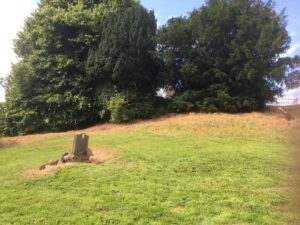So the church site in the townland of Templetate has been a centre of Christianity from the time of St Patrick.
Bishop Joseph Duffy writes that –
Templetate is the accepted site of the original Tigh Thalan, the place visited by St Patrick. The site is south of the present Church of Ireland (1788) in a circular graveyard. Tyholland occurs in the tenth-century Tripartite Life as the major church of the local kingdom of Uí Méith. (Monaghan History and Society).
The article in the Monaghan Angus (20 March 1954) already mentioned, states that local tradition asserts that the original church stood on the grassy mound beside the Church of Ireland in Templetate, while in 1948 the Very Rev David Wilson, Dean of St Patrick’s Cathedral, who grew up in the Tyholland Rectory, declared at a service in the church that ‘There has been a church here for fifteen centuries’. (Northern Standard, 26 Nov 1948).
 Southern part of Tyholland Church site
Southern part of Tyholland Church site
In 2017, in his Pentecostal address at a service in the church, Bishop Treanor, now His Excellency, The Most Reverend Noël Treanor, Apostolic Nuncio to the European Union, referred to the digging of the grave of Tommie Wright some decades ago on the south side of St Sillian’s when the foundation walls of an earlier church were revealed. Until some archaeological work takes place it is difficult to know if these walls are evidence of the pre-1787 church or of a much more ancient building.
The Rev Thomas Walsh in his History of the Hierachy already mentioned, writes of the ancient church at Tyholland being destroyed in AD 671 and that in AD 865 Cosgrach the anchorite (a religious recluse) and scribe of Tehallan died. All we can assert with assurance is that it has been widely believed for many centuries that a church or at least some ecclesiastical presence has been located on the church site in Templetate since the time of St Patrick in the fifth century.
In line with all this information it would seem plausible to state that there have been at least three churches at this site, a church or at least some kind of ancient ecclesiastical building, a pre-1787 church and the present one.
With regard to Bishop Cillian who was left by St Patrick at Tyholland presumably to lead the community there, the records to date are silent. However, Bishop Cillian appears to be the person from whom the present day name of the church St Sillian’s is derived. His feast day occurs on 27 May. One author of an article in the Irish Ecclesiastical Gazette about the dedication of churches, identifies the name of the church at Tyholland with St Sillian of Bangor, a sixth century saint who died in the first decade of the seventh century. (IEG, 21 March 1952, ‘To whom we dedicated’ by Rev E.A. Brandon, MA).
There is a little more information about this saint. He was born in the mid-sixth century and is said to have become a disciple of St Comgall, the first Abbot of Bangor, County Down. Sillian was distinguished for his virtues and learning and he became the professor and rector of the monastic school at Bangor. He succeeded the second abbot in 605 but according to the Annals of the Four Masters he died on 28 February 606, other annals differ with regard to the year.
It is possible that this holy man is the St Sillian associated with Tyholland as he appears to be the only saint of this name spelt with an ‘S’ but the general belief among historians is that the name St Sillian derives from Bishop Cillian left at Tyholland by St Patrick more than a century before the death of St Sillian of Bangor. The names Cillian and Sillian appear to be interchangeable in the context of the name of this church. It is spelt ‘Cilian’ on the 25 inch Ordnance Survey map, surveyed in the early twentieth century.
Up until the early 1940s the building is known as Tyholland Church in the parish records. The page in the Register of Baptisms beginning in 1943 names the church as St Cilians, as does the preachers’ book and this name continues to be entered at the top of the pages recording baptisms until 1973. By this time the Rev Broughton Mills was rector and he appears to have changed the spelling to St Sillian in the baptismal register. It appears to be the peculiarities of the clergy that established the present spelling of the names of both the church and the parish.